Considering Getting Fitted For Golf Clubs But Not Sure? Here's What To Expect
I started playing golf more seriously just about three years ago. I had gone out many times with my friends and probably played 3-4 times per year prior to that. When I played, I used a fairly cheap set of golf clubs.
But right around my 30th birthday, reality finally set in: I’m not going to be a professional baseball player. Yes, I played baseball my whole life before transitioning to competitive adult men’s softball. This is going to sound crazy, but I didn’t want golf to ruin my softball swing.
Anyway, fast-forward a few years and I joined a local golf club (shoutout Portland Golf Club in Portland, CT). I established a legitimate golf handicap and got some decent golf clubs for the first time in my life. Then, I started playing in competitive golf events. I was hooked.
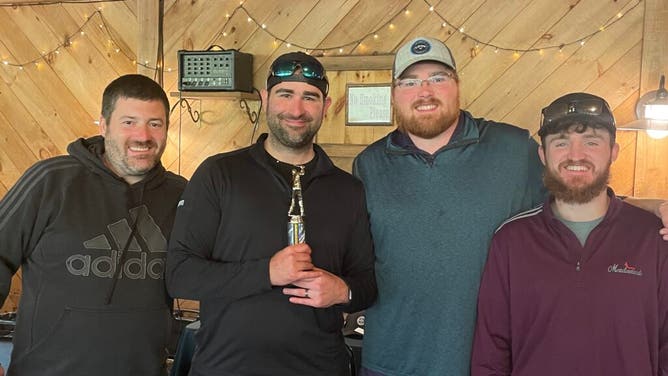
Me (holding the trophy, obviously) and the boys (from left to right: Aaron Craig, Rob Kofsuske and James Wagner) after winning the Portland Golf Club scramble to end the 2022-23 golf season.
But there was one aspect I always thought about but never actually did: get fitted for clubs. I had the thought that I think a lot of people have: “Am I good enough to get fitted?”
Full disclosure, I’m around an 18 handicap. I thought getting fitted was for people under 10, at minimum. Let me say this though: if that thought is what’s holding you back, let it go. No matter the skill level, the fitting is worth doing.
So, when PXG offered me the chance to have a custom fitting, I couldn’t turn it down. I’ve always been curious about the process and experience.
Getting fitted for an entire bag of golf clubs
I did an entire bag fitting: driver, irons, wedges, and putter. Yes, even putter. Honestly, I didn’t even know that was a thing.
For the fitting, I went to the PXG store Westchester in New York. They set me up with my fitter, Brandon. He told me the whole thing would take around 2 hours. It is not an “in-and-out” process; they really take their time to understand your swing and needs.
To start, I hit about five shots with my pitching wedge, just to warm up. We used an indoor set up with a top-of-the-line Trackman machine. Side note: if you’ve never used a Trackman before, the fitting is worth doing just for that part.
After I felt loose, Brandon told me a bit about PXG and their origin story. I won’t retell the whole thing here, but it’s fascinating. Essentially, the founder, Bob Parsons, wanted to make golf clubs as a passion project after he made a fortune in the tech industry.
So he hired a bunch of engineers and told them they had unlimited time and resources and their sole job was to make the best golf clubs they could.
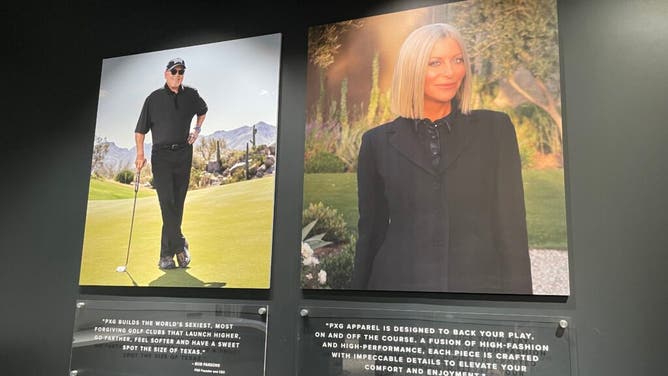
PXG founder Bob Parsons and his wife and PXG President, Renee Parsons.
Brandon explained about their clubs and what made them different. Some people might not care about that part. I’m a nerd at heart, so I found all of it interesting. He showed me one of their club heads cut in half so I could see inside the club behind the face.
Again, when most people think of a fitting – me included – they think of just hitting golf balls for an hour with different clubs trying to find the ones they like best.
But I loved the immersive process and the educational piece of the fitting. If you really love the game of golf, I think you’d enjoy this part too.
The fitting begins...
After that, we started the fitting. Brandon had me hit my current 7-iron a few times to make sure I was still warm. Then, he fired up the Trackman machine. I hit four shots with my current 7-iron.
Brandon asked a bunch of questions about it: what do you like about that club? What don’t you like? What’s your most common miss? He asked about the shift, the club and even the grip.
By the way, my iron miss is left. I hit a lot of hooks. Let me say this, too: a golf club fitting is not a golf lesson. However, if you’re like me and your fitter is knowledgeable about the game, you’re going to pick up some tips.
I asked Brandon why I keep hitting the ball left and he gave me the simplest tip that I couldn’t believe no one ever told me. At the end of my golf swing, I was turning my hands over like a baseball bat. That caused me to shut down my club face too early, thus the left hook.
He told me to think about my palm coming straight through the ball, more towards the sky. It worked like a charm.
Then, he started giving me PXG clubs to hit. We started with a 7 iron with the exact same shaft I was using on my current club. Your current club is referred to as your “gamer” by the way.
Brandon told me at the beginning: I’m going to give you clubs you’re going to love and clubs you’re going to hate, that’s all part of the process.
Trackman technology is mind-blowing
The beauty of the fitting is that we had this Trackman machine. So we could compare, down to the most minute details, exactly what each club was doing for me. I hit about five seven irons – sometimes we changed the club head, sometimes the shaft, sometimes both.
Then we looked at the results. There was a clear and obvious choice: I was able to hit one of the PXG seven irons 180 yards. With my “gamer” seven iron, my max was about 168. Even the most casual golfers know, if you can pick up 10-12 yards of distance per club, that’s a massive help.
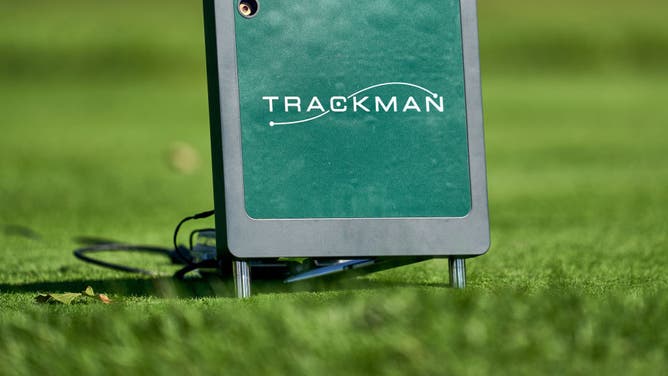
Trackman trackers help you learn about how you hit all the golf clubs in your bag. (Photo by Robin Alam/Icon Sportswire via Getty Images)
I can’t stress enough how awesome the Trackman is. I’ve hit on them before at indoor golf ranges, but I never fully understood all the data. That’s where Brandon comes in. He broke down what each number meant and what the goal for each statistic was.
Then he explained how he used all that data to do the club fitting. It’s a much more scientific process than I realized coming in.
Between my warmup swings and all my 7 iron swings, I had hit about 50 balls in 15-20 minutes. I was getting tired.
Brandon said they usually do the putter fitting last, but since we hit so many shots, he thought it would be a good idea to do the putter fitting to give the body a chance to recover before hitting drivers.
Note: be ready for a workout! You’re going to hit somewhere around 100 shots – for a lot of people reading this, that probably sounds familiar! – except you’re going to do it in two hours instead of the four it would take you to play a round of golf.
That part was pretty crazy, too. I had essentially played an entire round of golf by the end.
Thankfully, they supplied me with some bottles of water to stay hydrated.
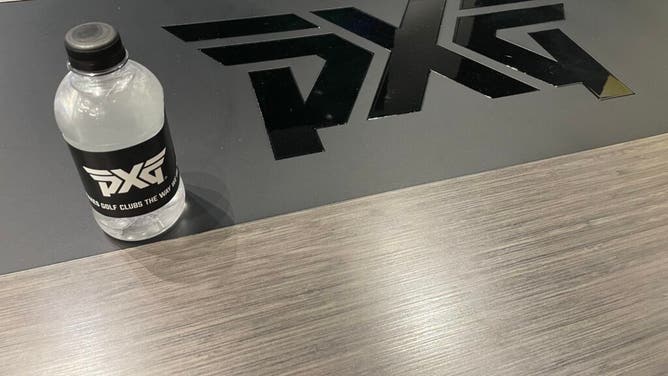
PXG store in Westchester, New York.
A putter fitting might seem strange, but it's one of the most important golf clubs
As far as putting goes, I consider myself to be a pretty good putter, and I use a center-shafted putter. I thought that gave me more control over the club. So I hit some putts with my current putter on a putter Trackman.
Ok, this technology I did not know existed. Brandon said most fitters don’t do putter fittings, but PXG does because it’s a big part of the golf game. And that’s true – somewhere around 30% of your golf shots are hit by your putter. It’s the only club that you use on every hole (for the most part).
This Trackman putter machine took videos of me putting to show the exact club and ball path. I felt like a PGA Tour pro for a brief moment.
And, it turns out, I needed a putter with slightly more toe hang. This became apparent rather quickly.
And, once again, Brandon shared a small tip to help my consistency. He told me I would get my arms a little too far from my body. He had me tuck my elbows in a bit more.
Sure enough, it worked immediately. Honestly, I found this to be the most fascinating part of the experience. Watching slow-mo videos of my putting stroke is something I never thought I’d do. But I’m extremely thankful they offer that as part of the fitting.
Ah yes, the driver...
Then, we moved on to driver. The process was fairly similar to the iron fitting; I started with my “gamer” to get a baseline, then I tried a PXG driver with the same shaft as my “gamer,” then we shifted to different combinations.
Once again, there was a clear and obvious club that I could hit farther than any other. One of my drives traveled 280 yards. I honestly couldn’t believe it. Literally, because if I hit a 280 yard drive down the middle playing actual golf I might just retire on the spot.
I sound like a broken record, but Brandon gave me a tip for my driver swing, too. He kept saying “we don’t want this to turn into a lesson…” and that’s true. A club fitting is not about “fixing” your golf game, it’s actually about matching clubs to the way YOU play golf.
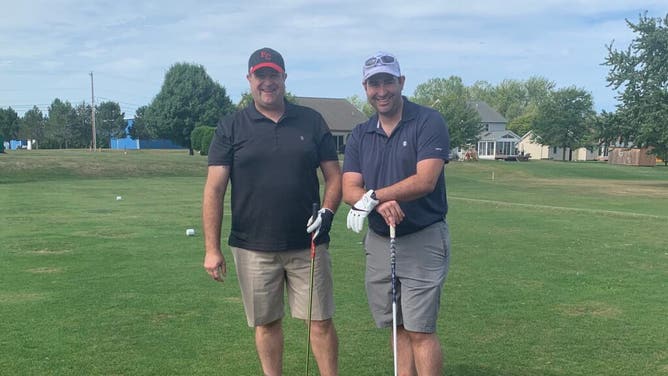
My dad and I with our golf clubs in Erie, Pennsylvania.
Brandon couldn’t stress enough that everyone has a unique swing and the best coaches (he used to coach golf professionally) adapt their teaching to the player’s current “move.” That’s another term I learned.
“Move” is, essentially, your golf swing. More specifically, the part where you attack the golf ball. Brandon said that my years of baseball affected my “move,” but that’s not a bad thing! You’re not going to unlearn 20 years of training, so you adapt it to golf.
For me, I hit my irons left but my driver goes right (and often slices, like a lot of amateur golfers). He told me to turn my shoulders so that my front shoulder pointed towards my target. Without me realizing, my front shoulder was always slightly open, but with driver only.
That led to my hips turning too quickly and the club lagging behind my body. Thus, an open club face and a slice.
Wedge fitting leads to an interesting lesson in golf club manufacturing processes
The final piece of the fitting was the wedge. The one thing that made this different is the golf club. Brandon explained that the PXG wedge is made through a milling process. He told me about the three ways golf clubs are made: milled, forged, and stamped.
Most clubs aren’t milled because it takes forever. But it creates an incredibly soft club face. I felt it, and it blew my mind. I had never seen or felt a club face like that. Plus, I later went and researched the three types of golf club manufacturing in more detail (because I’m a nerd, like I said).
Trackman can track the spin rate on the golf ball, too. When we did the iron and driver fitting, Trackman was set up as an open driving range. The goal was simply to track distance and direction. But when we did the wedge fitting, we switched to hitting at flag sticks.
And thanks to the Trackman, I could see the backspin I was getting with the milled wedge. I am not someone who can stick and spin back a sand wedge, so that part was cool to see.
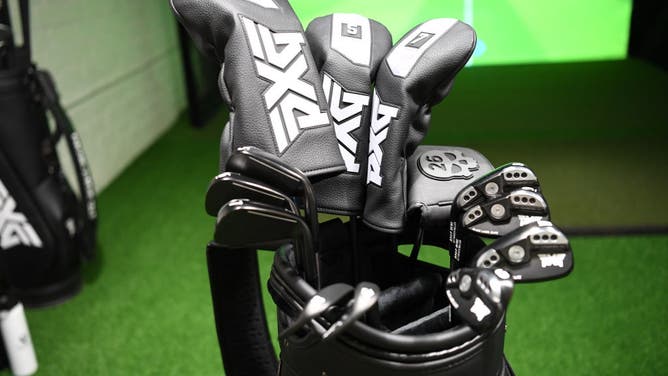
A view of atmosphere at the PXG x Nick Jonas at TRENDYGOLF USA on November 17, 2022 in El Segundo, California. (Photo by Jon Kopaloff/Getty Images for Parsons Xtreme Golf (PXG))
Overall, the entire thing took just a little bit more than two hours. I learned a TON about my golf game. Plus, Brandon emailed my ALL of the data from the entire session. That’s helpful, too, for when I go hit clubs on the range.
Just from that standpoint of getting a baseline of your golf swing, doing a fitting carries a ton of benefits. Plus, you have a chance to learn more about the game itself and pick up a few tips from an experienced golfer.
I went out with my buddies for my usual foursome the day after the fitting and played well – probably my best round this season. I could already see the benefits of the fitting in my game.
Well worth a couple hours of my time.